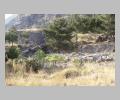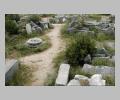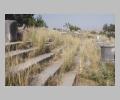| Context: | Priene |
| Type: | Stoa |
| Summary: | Two-aisled stoa located in the north of the agora in the center of the city. |
| Date: | ca. 160 BC - ca. 150 BC |
| Dimensions: | Length 116.46 m. (ext.); depth 16.77 m.; depth of portico 11.81 m. (int. - ext.). Doric outer colonnade: lower diameter 0.70 m.; axial intercolumniation 2.32 m.; height of columns 5.20 m.; height of entablature 1.52 m. Ionic inner colonnade: lower diameter 0.776 m.; axial intercolumniation 4.65 m.; height of columns 5.51 m. Shops: ca. 4.40 m. wide x 3.62 m. deep. |
| Region: | Ionia |
| Period: | Hellenistic |
Architectural Order:
Doric fully-fluted columns and Doric entablature on exterior colonnade; Ionic columns in interior, with lower third of the shaft unfluted.
Plan:
A two-aisled stoa facing south, with 15 rooms (shops) extending for ca. 76 m. from west end of stoa in the rear (north); closed side walls. 49 columns form the exterior colonnade, with 24 in the interior. A flight of six steps connects the stoa to the agora below.
Date Description:
The inscriptions on the walls of the stoa provide a secure terminus ante quem of ca. 130 B.C. An inscription on a block presumed to be an architrave of the exterior colonnade names Orophernes (or Ariarathes?) as dedicator; if the association of the block with the building is correct, the stoa should be dated to ca. 155 B.C. The combination of Doric and Ionic orders is also cited as evidence for a date in the second century B.C.
History:
Although the market clearly constituted an early element of Priene's town plan, the Sacred Stoa itself was not built until the middle of the second century B.C. The form of the building which must have occupied this location before the construction of the Sacred Stoa is not known, although the excavators postulate that a shorter stoa, possibly equal in length to the stoa along the south of the agora, stood here, based on the following evidence: the rear (north) wall of the rooms of the Sacred Stoa is the earliest element of the structure, and may once have formed the rear wall of an older stoa without rear rooms. Furthermore, the eastern section of the flight of six steps connecting the agora to the level of the stoa is of later construction, containing reused blocks; this suggests that the original stoa which stood here was shorter than the Sacred Stoa, and that the staircase was extended when the longer Sacred Stoa was constructed. This reconstruction, postulating an earlier structure, has been rejected by one scholar,
Other Notes:
A fragmentary text inscribed on the architrave of the exterior colonnade refers to the donor of the building:
restoring as the benefactor of the stoa Ariarathes VI, and providing a terminus post quem of ca. 130 B.C. Some have suggested, however, that the inscription may not belong to the stoa, and furthermore that the block on which it is inscribed may not be an architrave, but rather a statue base:
The title of the building is derived from an inscription carved on the west end wall: the inscription, of post-Mithradatic date, honors one Aulus Aemilius Zosimos and refers to the inscribing of the decree
Other Bibliography:





